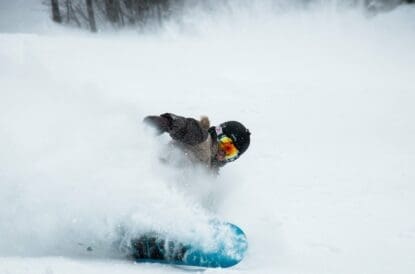Ski touring and split boarding have become increasingly popular in recent years, in part thanks to improvements in the safety of touring bindings, the lure of the backcountry and the ease of finding equipment both online and in ski shops. Important factors to consider when buying touring equipment include weight, usability, cost and durability; as with most things, only a few of these can be chosen without impacting on the rest. Some skiers will look to priorities speed and weight on the uphill, some will focus on the downhill experience. Thanks to improvements in technology, the gap between the two are closing.
Touring Skis
Skis for touring tend to fall into one of three categories – Race, Touring or Freetour. Whilst you can use pretty much any alpine ski for touring (if it allows you to fit skins), skis specially designed for touring are generally lighter weight and have a profile and camber which works well for off piste and for skinning uphill.
Touring Skis
Thin and lightweight, these are skis designed primarily for heading uphill. You won’t get the same stability as in some other touring skis, particularly freetour skis designed for the down as much as the up. Some feature tip and tail slots or fixtures to help with attaching skins. Core materials range from foam & wood to innovative carbon and honeycomb structures that make for a lighter ski. Swingweight is also considered with most proper touring skis making kick turns easier by balancing the weight along the ski.
Freetour skis
These are more like Freeride or All Mountain alpine skis that have gone on a bit of a diet. If you are doing short uphill skins to access off piste in and around resort then these are probably the skis for you. They aren’t the best for long expeditions, mostly due to their weight and width but if you want the best equipment to enjoy the rewards of the climb then choose Freetour skis. These have become the bedrock of the “hybrid” revolution in the last few years, bringing powerful downhill performance in a lightweight, uphill capable ski.
Race or SkiMo skis
These are designed specifically for Ski Mountaineering races, where speed is essential, not just in the climb but also in the transition and in the downhill. As a result, the skis are super light, usually have a system that allows for easy attachment and removal of skins and have little sidecut as SkiMo racers tend to straight line the downhill sections of the course. These skis are generally not particularly pleasant to ski on for either touring or freetouring, especially as their lightweight constructions means only a SkiMo pin binding can be utilised, so unless you are planning on racing probably best avoided.
Touring Bindings
Some of the biggest changes in touring equipment in the last five years have come in the shape of touring bindings; there are now four distinct categories that allow you to effectively choose adapt your setup for your ideal ski day:
- Lightweight Pin Bindings – featuring a basic pin setup at both toe and heel, these are for skiers that prioritise the uphill over the downhill. Incredibly lightweight, they can weight under 100g.
- Pin with Alpine Heel – featuring the same pin set up at the front, a traditional alpine heel piece (albeit with a handful of modifications to keep it out of the way on the uphill) provides security on the downhill, offering an excellent combination for skiers who love the uphill as much as the downhill.
- Hybrid Binding – one of biggest developments in skiing technology in any category in the last five years, hybrid bindings start off with a Pin & Alpine heel combo for the uphill, before a secure module clicks in over the toe pin to offer enhanced performance downhill. An exceptional bit of kit, added weight limits these bindings to short tours to find the very best powder just over the ridge.
- Frame Binding – feature a traditional alpine binding set up that hinges away from the ski in its entirety, these offer the same advantages and disadvantages as a Hybrid Binding but are falling out of fashion as the performance of Hybrid Bindings eats away at the utility of frame bindings.
Popular Touring Bindings by Type |
||||
| Brand | Type | |||
| Lightweight | Pin w/Alpine Heel | Hybrid | Frame | |
| Marker | Alpinist | Kingpin | Duke PT | F-Series Tour |
| Tyrolia | – | – | – | Adrenaline/Ambition |
| Dynafit* | DNA | – | – | – |
| Salomon/Atomic** | MTN Pure | – | S/LAB SHIFT or SHIFT | – |
| Look | Darklight | – | – | – |
| Armada | Tracer Tour | Shift MTN | N Shift | – |
| *Dynafit are industry leaders in super-lightweight and racing touring bindings, offering a complete range of Lightweight bindings. | ||||
| ** Owned by the same parent company, Salomon and Atomic utilise the same bindings under different brand names | ||||
Touring Boots
Boots fall into one of four categories for touring, although the lines between some of the can be a bit blurred – Alpine, Touring, Hybrid and Race.
Alpine boots are regular ski boots, these can only fit into frame type touring bindings and are not specifically designed for touring. Boots with a ‘walk mode’ tend to work better for touring as they can be switched to improve flexibility for uphill skinning.
Touring boots are designed to be comfortable and efficient going uphill and have a dedicated ‘walk mode’ for this purpose. They are generally lighter than regular ski boots and have metal toe piece and heel inserts to fit into pin bindings. The also tend to have a curved or ‘rockered’ sole which means they can’t fit into normal downhill ski bindings but should fit most frame touring bindings (there are exceptions so please check). Lighter boots are better for hut-to-hut or expedition touring but freetour boots give better control and power for downhill skiing.
Hybrid boots meet Alpine and Touring boots in the middle – not quite as lightweight or as upright as touring boots, but with pin compatibility and angled soles normally missing from alpine boots. One of the big developments in boot technology in the last half-decade, they bring downhill performance to lightweight uphill capability.
Race boots, like the skis and bindings, are ultralight and designed for speed rather than comfort or durability so shouldn’t be used for regular touring.
Touring Skins
Skins attach to the bottom of your skis in order to provide traction when travelling uphill. They attach via clips and usually a glue on the surface facing the ski base. There are various materials used, including mohair and/or synthetics to create a directional fabric that glides forward but stops the ski from slipping backwards. Most skins can be cut to fit the skis or splitboard you are using, some feature universal clips to attach at the tip of the ski and often the tail too. Some manufacturers have skin systems that clip on to special inserts in the skis.
Skins need to be taken care of in order to function correctly and last a reasonable amount of time. Caring for them includes drying them out properly after use and storing them the right way in your backpack or pockets as well as reproofing if they start to absorb water in use. Synthetic skins tend to be more durable and less prone to water ingress whilst mohair tend to glide better, pack smaller and weigh less. You can get blends of materials for the advantages of both. SkiMo racers tend to trim their skins to cover only the first 1/2 to 3/4 of the ski, this makes the easier to remove in transition, lighter weight and smoother to glide on flatter sections.
Touring Poles
If you are doing a lot of skinning where the slope angle changes then dedicated touring poles are a must. Touring poles are telescopic, so you can adjust the length on the fly, going along the flat – raise them for better leverage, traversing – drop one side for better balance. If you are splitboarding they are also an essential and many models pack down to under 50cm to stash on your backpack for the descent.
Other Touring Equipment
Don’t forget, most people tend to ski tour off piste; this means you should have a transceiver, shovel and probe, as well as knowledge of how to use them and awareness of avalanche safety are key.
Bring a backpack that is big enough to fit your shovel and probe, as well as space for layers; skinning up generates a lot of body heat, so you won’t want to wear many layers, however you will need them when you cool off when you stop or ski down. You can also put water and snacks here.
In some instances, ropes, harnesses and screws are carried to assist with crossing crevasses on glaciers and particularly tricky traverses. We don’t recommend doing this until you are experienced, and double check you have the right travel insurance for the job.
Summary
Want to free the heel and head up heel? Some things to remember:
- Leave racing and skimo kit to the pros; lightweight kit designed purely for the uphill means the downhill is a slog!
- Hybrid systems – meeting alpine and touring set-ups in the middle – have seen huge development in recent years, and provide a great solution for the semi-regular ski tourer
- Skins come in either mohair (a natural fibre from goat hair) or synthetic, or a blend of the two; mohair slides better, but synthetic dries out quicker and is more resilient
- A backpack big enough to fit layers in when touring up is essential






